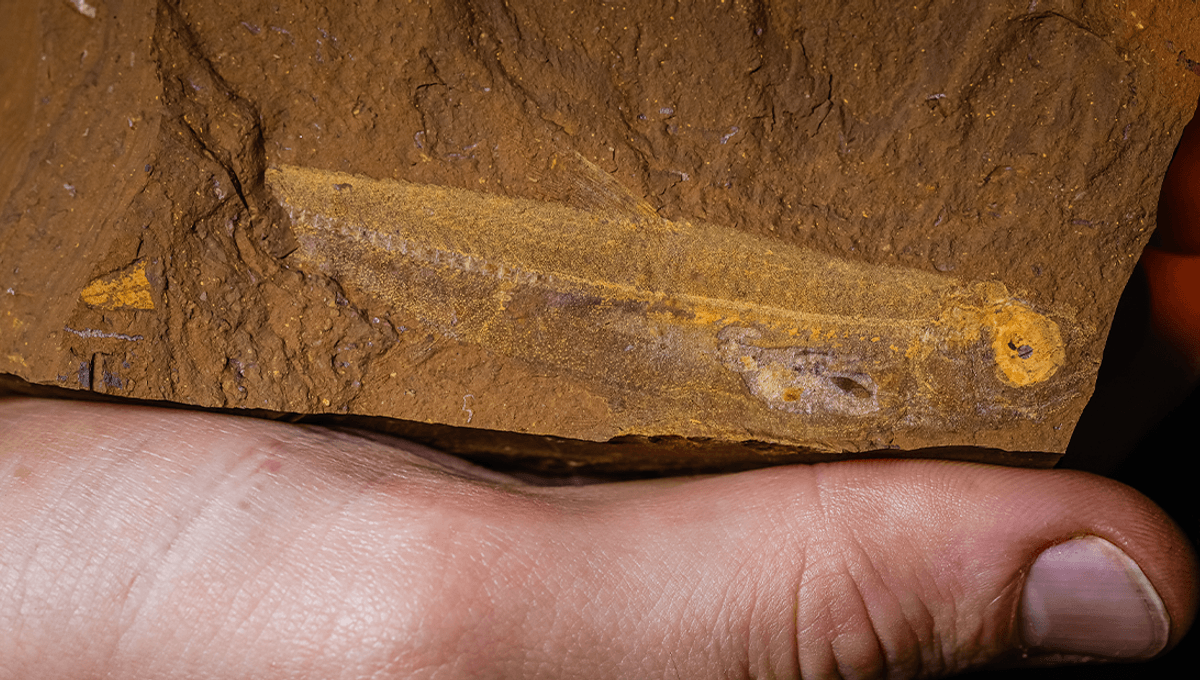
Fossilization is a tricky business; some species preserve only a few bones, while others are discovered with a one-in-a-billion level of completeness. Most would count themselves lucky to find a fossil or two of either kind, but this latest remarkable fishy find comes complete with a belly full of food.
ADVERTISEMENT
Discovered in the McGraths Flat fossil site in New South Wales, Australia, the new fossil is a freshwater smelt belonging to the order Osmerifiromes, the first of its kind to be found in Australia. While they are poorly represented in the fossil record, species in this order in Australia today are an important part of the freshwater biodiversity.
“The discovery of the 15 million-year-old freshwater fish fossil offers us an unprecedented opportunity to understand Australia’s ancient ecosystems and the evolution of its fish species, specifically the Osmeriformes group during the Miocene epoch, 11-15 million years ago,” study author Dr Matthew McCurry, who led the team that made the discovery, said in a statement.
The fossils are extraordinarily well preserved, in part due to the iron oxide-hydroxide mineral goethite that they were found embedded in. The team was even able to analyze the stomach contents of four of the specimens they found. In doing so, they discovered that the fossils contained large amounts of phantom midge larvae, suggesting that this was a vital part of their diet. In one specimen, a beetle could be seen between the jaws of the fish, while other stomach contents included insect wings of unknown species.
“Not only does this fossil provide a unique snapshot into the environment it lived in the Central Tablelands, but also because its stomach contents are so well preserved it allows us a glimpse into the behaviour of these ancient species. We now know that they fed on a range of invertebrates, but the most common prey was small phantom midge larvae,” McCurry said.
The fossil also revealed the color of the fish when it lived. Spots known as melanophores, which contain the pigment melanin, were found along the body of the fish in yellow or orange colors. The fish is thought to have been darker along its back, with two stripes running along the sides of its body, and a lighter color on its underside.
ADVERTISEMENT
“Using a powerful microscope, we were able to see tiny colour-producing structures known as melanosomes. Fossilised melanosomes have previously enabled palaeontologists to reconstruct the colour of feathers, but melanosomes have never been used to reconstruction of the colour pattern of a long extinct fish species,” said study author Dr Michael Frese, a researcher from the University of Canberra and CSIRO.
Remarkably, one of the specimens is preserved with a parasite attached to one of its fins. This is the parasitic larval stage of a freshwater mussel and is the first example of such an infection in the fossil record.
“These juvenile mussels attach themselves to the gills or tails of fish to hitch rides up and down streams,” McCurry added.
The new species has been named Ferruaspis brocksi, with the genus name coming from the Latin word ferrum, meaning iron, after the iron-rich environment it was found in, and “aspis”, meaning “shield” in Greek, which is commonly used for fossil fish. The species name is “brocksi” in honor of Professor Jochen J. Brocks, who discovered several of the fossils.
ADVERTISEMENT
“Collecting fossils at McGrath Flat is a highlight for me every year. Splitting the rust-red slabs of rock is like opening an ancient book, revealing the creatures that inhabited an Australian oxbow lake some 15 million years ago. This little fish is one of the most beautiful fossils there, and finding the first vertebrate among the abundant plant and insect fossils was a real surprise. Having F. brocksi named after me is a real joy,” said Brocks.
The study is published in the Journal of Vertebrate Paleontology.
Source Link: New Species Of 15-Million-Year-Old Fossil Fish Found With Perfectly Preserved Belly Full Of Food